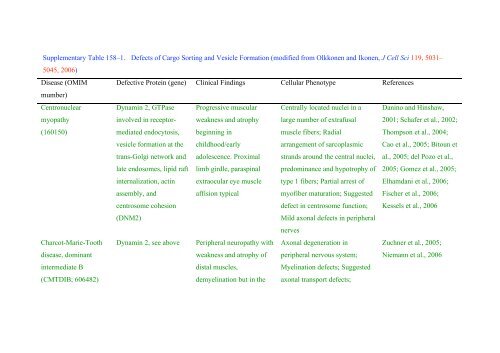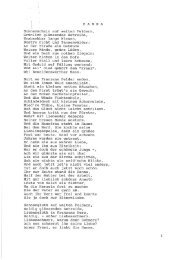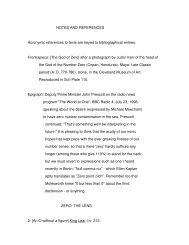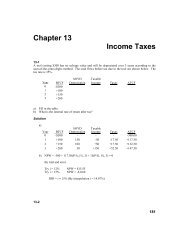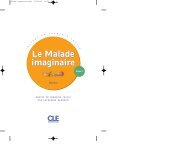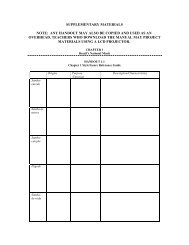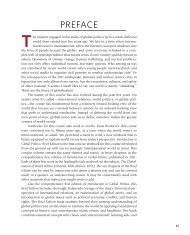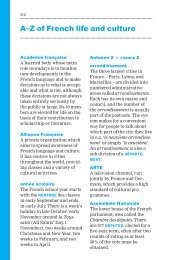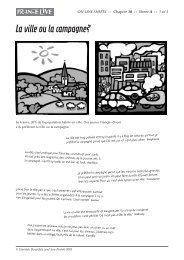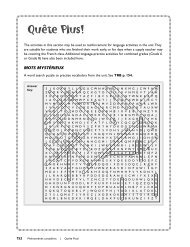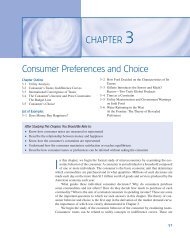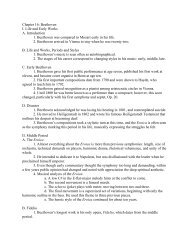Supplementary Table 158–1. Defects of Cargo Sorting and Vesicle ...
Supplementary Table 158–1. Defects of Cargo Sorting and Vesicle ...
Supplementary Table 158–1. Defects of Cargo Sorting and Vesicle ...
You also want an ePaper? Increase the reach of your titles
YUMPU automatically turns print PDFs into web optimized ePapers that Google loves.
<strong>Supplementary</strong> <strong>Table</strong> <strong>158–1.</strong> <strong>Defects</strong> <strong>of</strong> <strong>Cargo</strong> <strong>Sorting</strong> <strong>and</strong> <strong>Vesicle</strong> Formation (modified from Olkkonen <strong>and</strong> Ikonen, J Cell Sci 119, 5031–<br />
5045, 2006)<br />
Disease (OMIM<br />
mumber)<br />
Centronuclear<br />
myopathy<br />
(160150)<br />
Charcot-Marie-Tooth<br />
disease, dominant<br />
intermediate B<br />
(CMTDIB; 606482)<br />
Defective Protein (gene) Clinical Findings Cellular Phenotype References<br />
Dynamin 2, GTPase<br />
involved in receptor-<br />
mediated endocytosis,<br />
vesicle formation at the<br />
trans-Golgi network <strong>and</strong><br />
late endosomes, lipid raft<br />
internalization, actin<br />
assembly, <strong>and</strong><br />
centrosome cohesion<br />
(DNM2)<br />
Progressive muscular<br />
weakness <strong>and</strong> atrophy<br />
beginning in<br />
childhood/early<br />
adolescence. Proximal<br />
limb girdle, paraspinal<br />
extraocular eye muscle<br />
affision typical<br />
Dynamin 2, see above Peripheral neuropathy with<br />
weakness <strong>and</strong> atrophy <strong>of</strong><br />
distal muscles,<br />
demyelination but in the<br />
Centrally located nuclei in a<br />
large number <strong>of</strong> extrafusal<br />
muscle fibers; Radial<br />
arrangement <strong>of</strong> sarcoplasmic<br />
str<strong>and</strong>s around the central nuclei,<br />
predominance <strong>and</strong> hypotrophy <strong>of</strong><br />
type 1 fibers; Partial arrest <strong>of</strong><br />
my<strong>of</strong>iber maturation; Suggested<br />
defect in centrosome function;<br />
Mild axonal defects in peripheral<br />
nerves<br />
Axonal degeneration in<br />
peripheral nervous system;<br />
Myelination defects; Suggested<br />
axonal transport defects;<br />
Danino <strong>and</strong> Hinshaw,<br />
2001; Schafer et al., 2002;<br />
Thompson et al., 2004;<br />
Cao et al., 2005; Bitoun et<br />
al., 2005; del Pozo et al.,<br />
2005; Gomez et al., 2005;<br />
Elhamdani et al., 2006;<br />
Fischer et al., 2006;<br />
Kessels et al., 2006<br />
Zuchner et al., 2005;<br />
Niemann et al., 2006
Chorea-acanthocytosis<br />
(CHAC; 200150)<br />
Chylomicron retention<br />
disease (CMRD;<br />
246700)<br />
Anderson disease<br />
(607689)<br />
CMRD with<br />
Marinesco-Sjogren<br />
syndrome<br />
(607692)<br />
Chorein = VPS13A,<br />
homologue <strong>of</strong> S.c.<br />
vacuolar protein sorting<br />
factor Vps13p (VPS13A)<br />
Sar1b, small GTPase<br />
involved in vesicle<br />
budding from ER<br />
(SARA2)<br />
intermediate form nerve<br />
conduction velocities may<br />
be normal<br />
Gradual onset <strong>of</strong><br />
hyperkinetic movements<br />
closely resembling<br />
Humtington’s disease,<br />
abnormal erythrocyte<br />
morphology<br />
Severe fat malabsorption<br />
associated with failure to<br />
thrive in infancy,<br />
deficiency <strong>of</strong> fat soluble<br />
vitamins, low blood<br />
cholesterol, absence <strong>of</strong><br />
chylomicrons from blood<br />
Dynamin 2 mutant forms display<br />
decreased membrane association<br />
<strong>and</strong> induce disturbances in<br />
microtubule organization<br />
Red cell acanthocytosis; Basal<br />
ganglia atrophy in the brain;<br />
Suggested defect in protein<br />
cycling between trans-Golgi<br />
network, endosomes, <strong>and</strong> plasma<br />
membrane<br />
Accumulation <strong>of</strong> chylomicron-<br />
like particles in membrane-<br />
bound compartments <strong>of</strong><br />
enterocytes; Large lipid droplets<br />
in enterocytes<br />
Brickner <strong>and</strong> Fuller, 1997;<br />
Rampoldi et al., 2001;<br />
Ueno et al., 2001;<br />
Velayos-Baeza et al.,<br />
2004; Dobson-Stone et al.,<br />
2005<br />
Jones et al., 2003; Siddiqi<br />
et al., 2003; Shoulders et<br />
al., 2004; Siddiqi et al.,<br />
Cohen syndrome VPS13B, homologue <strong>of</strong> Microcephaly with Marked phenotypic variability; Brickner <strong>and</strong> Fuller, 1997;<br />
2006
(216550) S.c. vacuolar protein<br />
Combined deficiency<br />
<strong>of</strong> coagulation factors<br />
V <strong>and</strong> VIII<br />
(227300)<br />
Hermansky–Pudlak<br />
syndrome (HPS;<br />
203300)<br />
sorting factor Vps13p<br />
(COH1)<br />
ERGIC-53, ER-Golgi<br />
intermediate<br />
compartment sorter<br />
(LMAN1)<br />
-MCFD2, forms a<br />
complex with ERGIC-53<br />
(MCFD2)<br />
-type 2: adaptor-related<br />
protein complex 3 beta-1<br />
subunit (AP3B1).<br />
-types 1, 3–8:<br />
components <strong>of</strong> the<br />
biogenesis <strong>of</strong> lysosome-<br />
related organelles<br />
complexes (BLOC) 1, 2<br />
nonprogressive<br />
psychomotor retardation,<br />
retinal dystrophy,<br />
intermittent neutropenia<br />
Bleeding disorder<br />
characterized by<br />
coordinate reduction <strong>of</strong><br />
clotting factors V <strong>and</strong> VIII<br />
Oculo-cutaneous albinism,<br />
platelet defects with<br />
prolonged bleeding, types<br />
1 <strong>and</strong> 4: pulmonary<br />
fibrosis, type 2:<br />
neutropenia <strong>and</strong> mild<br />
immunodeficiency<br />
Cell biological consequences not<br />
extensively studied; Multiple<br />
neurological defects;<br />
Retinochoroidal dystrophy,<br />
neutropenia (not in all subjects)<br />
Defective secretion <strong>of</strong><br />
coagulation factors V <strong>and</strong> VIII<br />
due to disturbed sorting to ER-<br />
Golgi carrier vesicles<br />
Defective biogenesis <strong>of</strong><br />
lysosome-related organelles<br />
(melanosomes, platelet dense<br />
granules, lamellar bodies <strong>of</strong> type<br />
II alveolar epithelial cells, T-<br />
lymphocyte lytic granules);<br />
Leakage <strong>of</strong> lysosomal membrane<br />
proteins to cell surface<br />
Kolehmainen et al., 2003;<br />
Velayos-Baeza et al., 2004<br />
Nichols et al., 1998;<br />
Zhang et al., 2003; Zhang<br />
et al., 2005; Zhang et al.,<br />
2006<br />
Boissy et al., 1998;<br />
Dell’Angelica et al., 1999;<br />
Huizing et al., 2001;<br />
Robinson <strong>and</strong> Bonifacino,<br />
2001; Clark et al., 2003;<br />
Nazarian et al., 2003;<br />
Huizing et al., 2004;<br />
Peden et al., 2004; Di
Mucolipidosis II (I-cell<br />
disease; 252500)<br />
Mucolipidosis IIIA<br />
(classical Pseudo-<br />
Hurler poly-dystrophy;<br />
252600)<br />
Mucolipidosis IIIC<br />
(variant Pseudo-Hurler<br />
polydystrophy; 252605)<br />
Lowe<br />
oculocerebrorenal<br />
syndrome<br />
(309000)<br />
<strong>and</strong> 3 (DTNBP1<br />
encoding dysbindin,<br />
BLOC1S3; HPS3, HPS5,<br />
HPS6; HPS1, HPS4)<br />
N-acetylglucosamine-1-<br />
phosphotransferase,<br />
catalyses formation <strong>of</strong><br />
mannose 6-phosphate on<br />
lysosomal prot., α/β-<br />
subunits (GNPTAB)<br />
γ-subunit (GNPTAG)<br />
OCRL1, PtdIns(4,5)P2 5-<br />
phosphatase localized to<br />
the trans-Golgi network,<br />
early endosomes, <strong>and</strong><br />
clathrin-coated vesicles<br />
(OCRL1)<br />
Retarded psychomotor<br />
development,<br />
visceral <strong>and</strong> skeletal<br />
involvement with<br />
lysosomal deposition <strong>of</strong><br />
undegraded material<br />
Developmental disorder<br />
with congenital cataracts,<br />
renal tubular dysfunction<br />
<strong>and</strong> neurological deficits<br />
Leakage <strong>of</strong> lysosomal hydrolases<br />
from cells due to lack <strong>of</strong><br />
mannose-6-phosphate targeting<br />
signal; Lysosomal accumulation<br />
<strong>of</strong> undegraded macromolecules<br />
Secretion <strong>of</strong> lysosomal<br />
hydrolases; Abnormalities <strong>of</strong> the<br />
actin cytoskeleton;<br />
Accumulation <strong>of</strong> PtdIns(4,5)P2 ;<br />
Defective protein trafficking<br />
between trans-Golgi network<br />
<strong>and</strong> endosomes<br />
Pietro <strong>and</strong> Dell’Angelica,<br />
2005; Gautam et al., 2006;<br />
Wei, 2006)<br />
Raas-Rothschild et al.,<br />
2000, 2004; Tiede et al.,<br />
2005; Kudo et al., 2006<br />
Attree et al., 1992; Suchy<br />
et al., 1995; Zhang et al.,<br />
1995; Ungewickell et al.,<br />
2004; Choudhury et al.,<br />
2005; Halstead et al.,<br />
2005; Lowe, 2005; Hyvola<br />
et al., 2006;
Periventricular<br />
heterotopia with<br />
microcephaly<br />
(608097)<br />
Cranio-lenticulo-sutural<br />
dysplasia (CLSD;<br />
607812)<br />
References<br />
ARFGEF2 = BIG2,<br />
guanine nucleotide<br />
exchange factor for<br />
ARF (ARFGEF2)<br />
SEC23A, component <strong>of</strong><br />
the COPII coat that<br />
functions in membrane<br />
trafficking from the ER<br />
to the Golgi<br />
(SEC23A)<br />
Severe malformation <strong>of</strong> the<br />
cerebral cortex,<br />
developmental delay,<br />
recurrent infections; no<br />
evident anomalies outside<br />
the central nervous system<br />
Crani<strong>of</strong>acial<br />
dysmorphisms,<br />
sutural cataracts, mild<br />
skeletal dysplasia<br />
Defective neural precursor<br />
proliferation <strong>and</strong> neuron<br />
migration to cerebral cortex;<br />
Myelination defect; Experiments<br />
with cultured cells suggest<br />
function ARFGEF2 in both ER<br />
exit <strong>and</strong> post-Golgi vesicle<br />
transport<br />
Abnormal bone <strong>and</strong> connective<br />
tissue formation—potentially<br />
resulting from a defect in the<br />
secretion <strong>of</strong> extracellular matrix<br />
proteins; Dilatation <strong>of</strong> the ER in<br />
fibroblasts, cytoplasmic<br />
mislocalization <strong>of</strong> the COPII<br />
component SEC31<br />
Antonny B, Schekman R (2001). ER export: public transportation by the COPII coach. Curr Opin Cell Biol 13: 438–443.<br />
Charych et al., 2004;<br />
Sheen et al., 2004;<br />
Mouratou et al., 2005; Xu<br />
et al., 2005; Lu et al., 2006<br />
Barlowe et al., 1994;<br />
Antonny <strong>and</strong> Schekman,<br />
2001; Bonifacino <strong>and</strong><br />
Glick, 2004; Boyadjiev et<br />
al., 2006; Lang et al., 2006<br />
Attree O, Olivos IM, Okabe I, Bailey LC, Nelson DL, Lewis RA, McInnes RR, Nussbaum RL (1992). The Lowe’s oculocerebrorenal syndrome<br />
gene encodes a protein highly homologous to inositol polyphosphate-5-phosphatase. Nature 358: 239–242.
Barlowe C, Orci L, Yeung T, Hosobuchi M, Hamamoto S, Salama N, Rexach MF, Ravazzola M, Amherdt M, Schekman R (1994). COPII: a<br />
membrane coat formed by Sec proteins that drive vesicle budding from the endoplasmic reticulum. Cell 77: 895–907.<br />
Bitoun M, Maugenre S, Jeannet PY, Lacene E, Ferrer X, Laforet P, Martin JJ, Laporte J, Lochmuller H, Beggs AH, et al. (2005). Mutations in<br />
dynamin 2 cause dominant centronuclear myopathy. Nat Genet 37: 1207–1209.<br />
Boissy RE, Zhao Y, Gahl WA (1998). Altered protein localization in melanocytes from Hermansky-Pudlak syndrome: support for the role <strong>of</strong> the<br />
HPS gene product in intracellular trafficking. Lab Invest 78: 1037–1048.<br />
Bonifacino JS, Glick BS (2004). The mechanisms <strong>of</strong> vesicle budding <strong>and</strong> fusion. Cell 116: 153–166.<br />
Boyadjiev SA, Fromme JC, Ben J, Chong SS, Nauta C, Hur DJ, Zhang G, Hamamoto S, Schekman R, Ravazzola M, et al. (2006). Cranio-<br />
lenticulo-sutural dysplasia is caused by a SEC23A mutation leading to abnormal endoplasmic-reticulum-to-Golgi trafficking. Nat Genet 38:<br />
1192–1197.<br />
Brickner JH, Fuller RS (1997). SOI1 encodes a novel, conserved protein that promotes TGN-endosomal cycling <strong>of</strong> Kex2p <strong>and</strong> other membrane<br />
proteins by modulating the function <strong>of</strong> two TGN localization signals. J Cell Biol 139: 23–36.<br />
Cao H, Weller S, Orth JD, Chen J, Huang B, Chen JL, Stamnes M, McNiven MA (2005). Actin <strong>and</strong> Arf1-dependent recruitment <strong>of</strong> a cortactin-<br />
dynamin complex to the Golgi regulates post-Golgi transport. Nat Cell Biol 7: 483–492.<br />
Charych EI, Yu W, Miralles CP, Serwanski DR, Li X, Rubio M, De Blas AL (2004). The brefeldin A-inhibited GDP/GTP exchange factor 2, a<br />
protein involved in vesicular trafficking, interacts with the beta subunits <strong>of</strong> the GABA receptors. J Neurochem 90: 173–189.
Choudhury R, Diao A, Zhang F, Eisenberg E, Saint-Pol A, Williams C, Konstantakopoulos A, Lucocq J, Johannes L, Rabouille C, et al. (2005).<br />
Lowe syndrome protein OCRL1 interacts with clathrin <strong>and</strong> regulates protein trafficking between endosomes <strong>and</strong> the trans-Golgi network.<br />
Mol Biol Cell 16: 3467–3479.<br />
Clark RH, Stinchcombe JC, Day A, Blott E, Booth S, Bossi G, Hamblin T, Davies E.G, Griffiths GM (2003). Adaptor protein 3-dependent<br />
microtubule-mediated movement <strong>of</strong> lytic granules to the immunological synapse. Nat Immunol 4: 1111–1120.<br />
Danino D, Hinshaw JE (2001). Dynamin family <strong>of</strong> mechanoenzymes. Curr Opin Cell Biol 13: 454–460.<br />
del Pozo MA, Balasubramanian N, Alderson NB, Kiosses WB, Gr<strong>and</strong>e-Garcia A, Anderson RG, Schwartz MA (2005). Phospho-caveolin-1<br />
mediates integrin-regulated membrane domain internalization. Nat Cell Biol 7: 901–908.<br />
Dell’Angelica EC, Shotelersuk V, Aguilar RC, Gahl WA, Bonifacino JS (1999). Altered trafficking <strong>of</strong> lysosomal proteins in Hermansky-Pudlak<br />
syndrome due to mutations in the beta 3A subunit <strong>of</strong> the AP-3 adaptor. Mol Cell 3: 11–21.<br />
Di Pietro SM, Dell’Angelica EC (2005). The cell biology <strong>of</strong> Hermansky-Pudlak syndrome: recent advances. Traffic 6: 525–533.<br />
Dobson-Stone C, Velayos-Baeza A, Jansen A, Andermann F, Dubeau F, Robert F, Summers A, Lang AE, Chouinard S, Danek A, et al. (2005).<br />
Identification <strong>of</strong> a VPS13A founder mutation in French Canadian families with chorea-acanthocytosis. Neurogenetics 6: 151–158.<br />
Elhamdani A, Azizi F, Solomaha E, Palfrey HC, Artalejo CR (2006). Two mechanistically distinct forms <strong>of</strong> endocytosis in adrenal chromaffin<br />
cells: Differential effects <strong>of</strong> SH3 domains <strong>and</strong> amphiphysin antagonism. FEBS Lett 580: 3263–3269.<br />
Fischer D, Herasse M, Bitoun M, Barragan-Campos HM, Chiras J, Laforet P, Fardeau M, Eymard B, Guicheney P, Romero NB (2006).<br />
Characterization <strong>of</strong> the muscle involvement in dynamin 2-related centronuclear myopathy. Brain 129: 1463–1469.
Gautam R, Novak EK, Tan J, Wakamatsu K, Ito S, Swank RT (2006). Interaction <strong>of</strong> Hermansky-Pudlak Syndrome genes in the regulation <strong>of</strong><br />
lysosome-related organelles. Traffic 7: 779–792.<br />
Gomez TS, Hamann MJ, McCarney S, Savoy DN, Lubking CM, Heldebrant MP, Labno CM, McKean DJ, McNiven MA, Burkhardt JK, et al.<br />
(2005). Dynamin 2 regulates T cell activation by controlling actin polymerization at the immunological synapse. Nat Immunol 6: 261–270.<br />
Halstead JR, Jalink K, Divecha N (2005). An emerging role for PtdIns(4,5)P2-mediated signalling in human disease. Trends Pharmacol Sci 26:<br />
654–660.<br />
Huizing M, Sarangarajan R, Strovel E, Zhao Y, Gahl WA, Boissy RE (2001). AP-3 mediates tyrosinase but not TRP-1 trafficking in human<br />
melanocytes. Mol Biol Cell 12: 2075–2085.<br />
Huizing M, Hess R, Dorward H, Claassen DA, Helip-Wooley A, Kleta R, Kaiser-Kupfer MI, White JG, Gahl WA (2004). Cellular, molecular<br />
<strong>and</strong> clinical characterization <strong>of</strong> patients with Hermansky-Pudlak syndrome type 5. Traffic 5: 711–722.<br />
Hyvola N, Diao A, McKenzie E, Skippen A, Cockcr<strong>of</strong>t S, Lowe M (2006). Membrane targeting <strong>and</strong> activation <strong>of</strong> the Lowe syndrome protein<br />
OCRL1 by rab GTPases. Embo J 25(16): 3750–3761.<br />
Jones B, Jones EL, Bonney SA, Patel HN, Mensenkamp AR, Eichenbaum-Voline S, Rudling M, Myrdal U, Annesi G, Naik S, et al. (2003).<br />
Mutations in a Sar1 GTPase <strong>of</strong> COPII vesicles are associated with lipid absorption disorders. Nat Genet 34: 29–31.<br />
Kessels MM, Dong J, Leibig W, Westermann P, Qualmann B (2006). Complexes <strong>of</strong> syndapin II with dynamin II promote vesicle formation at<br />
the trans-Golgi network. J Cell Sci 119: 1504–1516.
Kolehmainen J, Black GC, Saarinen A, Ch<strong>and</strong>ler K, Clayton-Smith J, Traskelin AL, Perveen R, Kivitie-Kallio S, Norio R, Warburg M, et al.<br />
(2003). Cohen syndrome is caused by mutations in a novel gene, COH1, encoding a transmembrane protein with a presumed role in vesicle-<br />
mediated sorting <strong>and</strong> intracellular protein transport. Am J Hum Genet 72: 1359–1369.<br />
Kudo M, Brem MS, Canfield WM (2006). Mucolipidosis II (I-cell disease) <strong>and</strong> mucolipidosis IIIA (classical pseudo-hurler polydystrophy) are<br />
caused by mutations in the GlcNAc-phosphotransferase alpha / beta -subunits precursor gene. Am J Hum Genet 78: 451–463.<br />
Lang MR, Lapierre LA, Frotscher M, Goldenring JR, Knapik EW (2006). Secretory COPII coat component Sec23a is essential for crani<strong>of</strong>acial<br />
chondrocyte maturation. Nat Genet 38: 1198–1203.<br />
Lowe M (2005). Structure <strong>and</strong> function <strong>of</strong> the Lowe syndrome protein OCRL1. Traffic 6: 711–719.<br />
Lu J, Tiao G, Folkerth R, Hecht J, Walsh C, Sheen V (2006). Overlapping expression <strong>of</strong> ARFGEF2 <strong>and</strong> Filamin A in the neuroependymal lining<br />
<strong>of</strong> the lateral ventricles: insights into the cause <strong>of</strong> periventricular heterotopia. J Comp Neurol 494: 476–484.<br />
Mouratou B, Biou V, Joubert A, Cohen J, Shields DJ, Geldner N, Jurgens G, Melancon P, Cherfils J (2005). The domain architecture <strong>of</strong> large<br />
guanine nucleotide exchange factors for the small GTP-binding protein Arf. BMC Genomics 6: 20.<br />
Nazarian R, Falcon-Perez JM, Dell’Angelica EC (2003). Biogenesis <strong>of</strong> lysosome-related organelles complex 3 (BLOC-3): a complex containing<br />
the Hermansky-Pudlak syndrome (HPS) proteins HPS1 <strong>and</strong> HPS4. Proc Natl Acad Sci USA 100: 8770–8775.<br />
Nichols WC, Seligsohn U, Zivelin A, Terry VH, Hertel CE, Wheatley MA, Moussalli MJ, Hauri HP, Ciavarella N, Kaufman RJ, et al. (1998).<br />
Mutations in the ER-Golgi intermediate compartment protein ERGIC-53 cause combined deficiency <strong>of</strong> coagulation factors V <strong>and</strong> VIII. Cell<br />
93: 61–70.<br />
Niemann A, Berger P, Suter U (2006). Pathomechanisms <strong>of</strong> mutant proteins in Charcot-Marie-Tooth disease. Neuromolecular Med 8: 217–242.
Peden AA, Oorschot V, Hesser BA, Austin CD, Scheller RH, Klumperman J (2004). Localization <strong>of</strong> the AP-3 adaptor complex defines a novel<br />
endosomal exit site for lysosomal membrane proteins. J Cell Biol 164: 1065–1076.<br />
Raas-Rothschild A, Cormier-Daire V, Bao M, Genin E, Salomon R, Brewer K, Zeigler M, M<strong>and</strong>el H, Toth S, Roe B, et al. (2000). Molecular<br />
basis <strong>of</strong> variant pseudo-hurler polydystrophy (mucolipidosis IIIC). J Clin Invest 105: 673–681.<br />
Raas-Rothschild A, Bargal R, Goldman O, Ben-Asher E, Groener JE, Toutain A, Stemmer E, Ben-Neriah Z, Flusser H, Beemer FA, et al.<br />
(2004). Genomic organisation <strong>of</strong> the UDP-N-acetylglucosamine-1-phosphotransferase gamma subunit (GNPTAG) <strong>and</strong> its mutations in<br />
mucolipidosis III. J Med Genet 41: e52.<br />
Rampoldi L, Dobson-Stone C, Rubio JP, Danek A, Chalmers RM, Wood NW, Verellen C, Ferrer X, Mal<strong>and</strong>rini A, Fabrizi GM, et al. (2001). A<br />
conserved sorting-associated protein is mutant in chorea-acanthocytosis. Nat Genet 28: 119–120.<br />
Robinson MS, Bonifacino JS (2001). Adaptor-related proteins. Curr Opin Cell Biol 13: 444–453.<br />
Schafer DA, Weed SA, Binns D, Karginov AV, Parsons JT, Cooper JA (2002). Dynamin2 <strong>and</strong> cortactin regulate actin assembly <strong>and</strong> filament<br />
organization. Curr Biol 12: 1852–1857.<br />
Sheen VL, Ganesh VS, Topcu M, Sebire G, Bodell A, Hill RS, Grant PE, Shugart YY, Imitola J, Khoury SJ, et al. (2004). Mutations in<br />
ARFGEF2 implicate vesicle trafficking in neural progenitor proliferation <strong>and</strong> migration in the human cerebral cortex. Nat Genet 36: 69–76.<br />
Shoulders CC, Stephens DJ, Jones B (2004). The intracellular transport <strong>of</strong> chylomicrons requires the small GTPase, Sar1b. Curr Opin Lipidol<br />
15: 191–197.<br />
Siddiqi SA, Gorelick FS, Mahan JT, Mansbach CM 2nd (2003). COPII proteins are required for Golgi fusion but not for endoplasmic reticulum<br />
budding <strong>of</strong> the pre-chylomicron transport vesicle. J Cell Sci 116: 415–427.
Siddiqi SA, Siddiqi S, Mahan J, Peggs K, Gorelick FS, Mansbach CM (2006). The identification <strong>of</strong> a novel endoplasmic reticulum to Golgi<br />
SNARE complex used by the Pre-chylomicron transport vesicle. J Biol Chem 281(30): 20974–20982.<br />
Suchy SF, Olivos-Gl<strong>and</strong>er IM, Nussabaum RL (1995). Lowe syndrome, a deficiency <strong>of</strong> phosphatidylinositol 4,5-bisphosphate 5-phosphatase in<br />
the Golgi apparatus. Hum Mol Genet 4: 2245–2250.<br />
Thompson HM, Cao H, Chen J, Euteneuer U, McNiven MA (2004). Dynamin 2 binds gamma-tubulin <strong>and</strong> participates in centrosome cohesion.<br />
Nat Cell Biol 6: 335–342.<br />
Tiede S, Storch S, Lubke T, Henrissat B, Bargal R, Raas-Rothschild A, Braulke T (2005). Mucolipidosis II is caused by mutations in GNPTA<br />
encoding the alpha/beta GlcNAc-1-phosphotransferase. Nat Med 11: 1109–1112.<br />
Ueno S, Maruki Y, Nakamura M, Tomemori Y, Kamae K, Tanabe H, Yamashita Y, Matsuda S, Kaneko S, Sano A (2001). The gene encoding a<br />
newly discovered protein, chorein, is mutated in chorea-acanthocytosis. Nat Genet 28: 121–122.<br />
Ungewickell A, Ward ME, Ungewickell E, Majerus PW (2004). The inositol polyphosphate 5-phosphatase Ocrl associates with endosomes that<br />
are partially coated with clathrin. Proc Natl Acad Sci USA 101: 13501–13506.<br />
Wei ML (2006). Hermansky-Pudlak syndrome: a disease <strong>of</strong> protein trafficking <strong>and</strong> organelle function. Pigment Cell Res 19: 19–42.<br />
Velayos-Baeza A, Vettori A, Copley RR, Dobson-Stone C, Monaco AP (2004). Analysis <strong>of</strong> the human VPS13 gene family. Genomics 84: 536–<br />
549.<br />
Xu KF, Shen X, Li H, Pacheco-Rodriguez G, Moss J, Vaughan M (2005). Interaction <strong>of</strong> BIG2, a brefeldin A-inhibited guanine nucleotide-<br />
exchange protein, with exocyst protein Exo70. Proc Natl Acad Sci USA 102: 2784–2789.
Zhang B, Cunningham MA, Nichols WC, Bernat JA, Seligsohn U, Pipe SW, McVey JH, Schulte-Overberg U, de Bosch NB, Ruiz-Saez A, et al.<br />
(2003). Bleeding due to disruption <strong>of</strong> a cargo-specific ER-to-Golgi transport complex. Nat Genet 34: 220–225.<br />
Zhang B, Kaufman RJ, Ginsburg D (2005). LMAN1 <strong>and</strong> MCFD2 form a cargo receptor complex <strong>and</strong> interact with coagulation factor VIII in the<br />
early secretory pathway. J Biol Chem 280: 25881–25886.<br />
Zhang B, McGee B, Yamaoka JS, Guglielmone H, Downes KA, Minoldo S, Jarchum G, Peyv<strong>and</strong>i F, de Bosch NB, Ruiz-Saez A, et al. (2006).<br />
Combined deficiency <strong>of</strong> factor V <strong>and</strong> factor VIII is due to mutations in either LMAN1 or MCFD2. Blood 107: 1903–1907.<br />
Zhang X, Jefferson AB, Auethavekiat V, Majerus PW (1995). The protein deficient in Lowe syndrome is a phosphatidylinositol-4,5-<br />
bisphosphate 5-phosphatase. Proc Natl Acad Sci USA 92: 4853–4856.<br />
Zuchner S, Noureddine M, Kennerson M, Verhoeven K, Claeys K, De Jonghe P, Merory J, Oliveira SA, Speer MC, Stenger JE, et al. (2005).<br />
Mutations in the pleckstrin homology domain <strong>of</strong> dynamin 2 cause dominant intermediate Charcot-Marie-Tooth disease. Nat Genet 37: 289–<br />
294.


